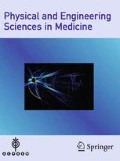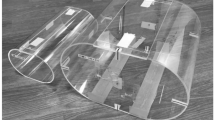Abstract
The use of parameters water equivalent diameter (D W ) and size-specific dose estimate (SSDE) are becoming increasingly established as a recognised method to relate patient dose from a CT examination to the dose indicator volume CT dose index (CTDIVOL). However, the role of the attenuation due to the patient table in these estimations requires careful consideration and is the subject of this study. The aim of this study is to investigate the impact of a minimal part of the patient table when calculating the D W and SSDE. We investigated 164 patients who had undergone CT examinations for the pelvis, abdomen, thorax and head. We subsequently calculated D W and SSDE using two methods: one using a small circular region of interest (ROI) including a minimal part of the patient table and the other using a ROI fitted to the patient border alone. The results showed that the water equivalent diameter calculated with the table included in the ROI (D W,t ) is greater, compared to that without the consideration of the patient table (D W,nt ), by 1.5–6.2% depending on the anatomy being imaged. On the other hand, the SSDE calculated with inclusion of the patient table (SSDEt) is smaller than otherwise (SSDEnt) by 1.0–5.5% again depending on the anatomy being imaged. The effect of the patient table on D W and SSDE in the thorax CT examination was statistically significant, but its effect on D W and SSDE in the other examinations of head, pelvis and abdomen was relatively small and not statistically significant.

Similar content being viewed by others
References
Slovis TL (2002) CT and computed radiography: the picture are great, but is the radiation dose greater than required? AJR Am J Roentgenol 179:39–41
Dawson P (2004) Patient dose in multislice CT: why is it increasing and does it matters? Br J Radiol 77:S10–S13
Bauhs JA, Vrieze TJ, Primak AN, Bruesewitz MR, McCollough CH (2008) CT dosimetry: comparison of measurement techniques and devices. RadioGraphics 28:245–253
Rehani MM, Berry M (2000) Radiation doses in computed tomography: the increasing doses of radiation need to be controlled. BMJ 320:593–594
Brenner DJ, Elliston CD, Hall EJ, Berdon W (2001) Estimated risks of radiation-induced fatal cancer from paediatric CT. AJR Am J Roentgenol 176:289–296
Parker L (2001) Computed tomography scanning in children: radiation risks. Pediatr Hematol Oncol 18:307–308
Brenner DJ, Elliston CD (2004) Estimated radiation risks potentially associated with full-body screening. Radiology 232:338–735
United Nations Scientific Committee on the Effects of Atomic Radiation (2010) Sources and effects of ionizing radiation, UNSCEAR 2008 Report to the General Assembly, with Scientific Annexes, United Nations, New York
National Council on Radiation Protection and Measurements (2009) Ionizing radiation exposure of the population of the United States. NCRP rep. 160
Hayton A, Wallace A, Marks P, Edmonds K, Tingey D, Johnston P (2013) Australian per caput dose from diagnostic imaging and nuclear medicine. Radiat Prot Dosimetry 156:445–450
Shope TB, Gagne RM, Johnson GC (1981) A method for describing the doses delivered by transmission X-ray computed tomography. Med Phys 8:488–495
American Association of Physicists in Medicine (2008) The measurement, reporting, and management of radiation dose in CT. AAPM report no. 96
Kalender WA (2014) Dose in X-ray computed tomography. Phys Med Biol 59:R129–R150
Huda W, Mettler FA (2011) Volume CT dose index and dose-length product displayed during CT: what good are they? Radiology 258:236–242
McCollough CH, Leng S, Lifeng Y, Cody DD, Boone JM, McNitt-Gray MF (2011) CT dose index and patient dose: they are not the same thing. Radiology 259:311–316
Brink JA, Morin RL (2012) Size-specific dose estimation for CT: how should it be used and what does it mean? Radiology 265:666–668
Anam C, Haryanto H, Widita R, Arif I, Dougherty G (2016) Profile of CT scan output dose in axial and helical modes using convolution. J Phys Conf Ser 694:012034
Nickoloff EL, Dutta AK, Lu ZF (2003) Influence of phantom diameter, kVp and scan mode upon computed tomography dose Index. Med Phys 30:395–402
Nasir M, Pratama D, Anam C, Haryanto F (2016) Calculation of size specific dose estimates (SSDE) value at cylindrical phantom from varian OBI CBCT v1.4 X-ray tube EGSnrc monte carlo simulation based. J Phys Conf Ser 694:012040
American Association of Physicists in Medicine (2011) Size-specific dose estimates (SSDE) in pediatric and adult body CT examinations. AAPM report no. 204
Anam C, Haryanto F, Widita R, Arif I (2015) Automated estimation of patient’s size from 3D image of patient for size-specific dose estimates (SSDE). Adv Sci Eng Med 7:892–896
Li X, Samei E, Segars WP, Sturgeon GM, Colsher JG, Frush DP (2008) Patient-specific dose estimation for pediatric chest CT. Med Phys 35:5821–5828
Huda W, Scalzetti EM, Roskopf M (2000) Effective doses to patients undergoing thoracic computed tomography examinations. Med Phys 27:838–844
Menke J (2005) Comparison of different body size parameters for individual dose adaptation in body CT of adults. Radiology 236:565–571
Toth T, Ge Z, Daly MP (2007) The influence of patient centering on CT dose and image noise. Med Phys 34:3093–3101
American Association of Physicists in Medicine (2014) Use of water equivalent diameter for calculating patient size and size-specific dose estimates (SSDE) in CT. AAPM report no. 220
Wang J, Duan X, Christner JA, Leng S, Yu L, McCollough CH (2012) Attenuation-based estimation of patient size for the purpose of size specific dose estimation in CT. Part I. Development and validation of methods using the CT image. Med Phys 39:6764–6771
Khatonabadi M, Oria D, Mok K, Cagnon CH, DeMarco JJ, McNitt-Gray MF (2013) Calculating size specific dose estimates (SSDE): the effect of using water equivalent diameter (WED) vs. effective diameter (ED) on organ dose estimates when applying the conversion coefficients of TG 204. In 55th annual AAPM meeting. Indianapolis, Indiana
Wang J, Christner JA, Duan Y, Leng S, Yu L, McCollough CH (2012) Attenuation-based estimation of patient size for the purpose of size specific dose estimation in CT. Part II. Implementation on abdomen and thorax phantoms using cross sectional CT images and scanned projection radiograph images. Med Phys 39:6772–6778
Bostani M, McMillan K, Lu P, Kim HJ, Cagnon CH, Demarco JJ, McNitt-Gray MF (2015) Attenuation-based size metric for estimating organ dose to patients undergoing tube current modulated CT exams. Med Phys 42:958–968
Anam C, Haryanto F, Widita R, Arif I, Dougherty G (2016) Automated calculation of water-equivalent diameter (DW) based on AAPM task group 220. J Appl Clin Med Phys 17:320–333
Anam C, Haryanto F, Widita R, Arif I, Dougherty G (2016) A fully automated calculation of size-specific dose estimates (SSDE) in thoracic and head CT examinations. J Phys Conf Ser 694:012030
Brady SL, Kaufman RA (2012) Investigation of American Association of Physicists in Medicine report 204 size-specific dose estimates for pediatric CT implementation. Radiology 265:832–840
Li X, Samei E, Segars WP, Sturgeon GM, Colsher JG, Frush DP (2011) Patient-specific radiation dose and cancer risk for pediatric chest CT. Radiology 259:862–874
Acknowledgements
This work was funded by the Research and Innovation Program, Bandung Institute of Technology (ITB), No. 006n/I1.C01/PL/2016. The authors would like to thank Mr. Sanggam Ramantisan from Kensaras Hospital, Semarang, Indonesia.
Author information
Authors and Affiliations
Corresponding author
Rights and permissions
About this article
Cite this article
Anam, C., Haryanto, F., Widita, R. et al. The impact of patient table on size-specific dose estimate (SSDE). Australas Phys Eng Sci Med 40, 153–158 (2017). https://doi.org/10.1007/s13246-016-0497-z
Received:
Accepted:
Published:
Issue Date:
DOI: https://doi.org/10.1007/s13246-016-0497-z




